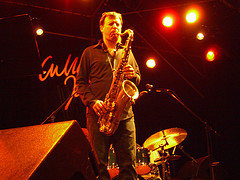Oct 7, 2010
Chris Potter at the Regattabar, 2nd Set, October 6, 2010
 First thing I noticed was that Chris Potter doesn’t have an iPhone. He took a call right before the set and it looked like he just had one of those free phones, or maybe a Blackberry. A Blackberry would make sense – as one of the leading tenors of the day, he’s got a business to run – but, somehow, an iPhone would have made more sense.
First thing I noticed was that Chris Potter doesn’t have an iPhone. He took a call right before the set and it looked like he just had one of those free phones, or maybe a Blackberry. A Blackberry would make sense – as one of the leading tenors of the day, he’s got a business to run – but, somehow, an iPhone would have made more sense.
Chris Potter plays with the precision, force and lucidity that I associate with Stan Getz. His harmonic conception is palpably modern stemming as it does from Coltrane, of course, but even more obviously, at least to these ears, from Wayne Shorter. Last night he led the band through a set comprised primarily of new and, as Potter pointed out, untitled compositions, many reminiscent of the cyclical openness of Shorter’s mid-sixties work, though one at least, the last number, sounding fairly Zawinul-esque.
In other words, the evening provided a healthy dose of melodic and spacious dynamism that was simultaneously grounded, cerebral, and even atmospheric.
Last time I saw Potter he was accompanied by the guitarist Adam Rogers and I was struck then by Rogers’ mastery of myriad styles from bebop to fusion to funk-rock. Last night, I had a similar feeling about Potter’s talent; he has obviously subsumed the dominant tenor strains of the last fifty years and continues to deploy and forge them into a deliberate and individualized sound.
The main challenge for someone at Potter’s level of playing is not sounding too much like any of the guys he could sound like. Following in Shorter’s footsteps helps him do this since the latter’s career was literally born in Coltrane’s shadow (Trane had recommended him as a replacement for himself to Miles). Shorter of course, whose playing in the 60s bears some un-mistakable Trane-isms, went on to build a towering body of work characterized by a nuanced, engaging and distinctive vision. Potter’s oeuvre, for its part, remains a compellingly evolved work in progress.
Potter did sound sort of Trane-y at times, especially on one self-penned ballad. In fact, he even took the band on an extended, Eastern modal workout right out of Trane’s playbook. I was glad to see him take the head with his tenor but, inevitably, he reached for the soprano and I thought we were moving straight into imitative homage territory. I was pleasantly surprised, however. Potter’s soprano tone was more in the controlled, Jan Garbarek vein and, in fact, highlighted by contrast the helter-skelter, jittery and frantic nature of Trane’s.
Potter’s supporting cast featured Larry Grenadier on bass, Edward Simon on piano, and Marcus Gilmore on drums. Grenadier is a pro – thoughtful, lyrical, focused. Marcus Gilmore is full of energy and ideas and a deft juggler of simultaneously independent rhythmic flows and phrases. Simon produced endlessly beautiful and absorbing tableaux which, unfortunately, I was not always able to adequately descry, seated as I was some five feet behind the cauldron of Gilmore’s drum kit.
A young Berklee kid sat down next to me right before things jumped off. We were chatting and he asked me if “I played.” I’ve been playing guitar for over thirty years but I’m so self-conscious about my abilities that I responded, “Ah, I’m just a hacker. A journeyman.”
Later, as the band kicked in and I started to get a little lost in the music, I realized I should have told him the truth: I’m a latter-day beatnik jazz mystic type of guy. Ever since I heard Coltrane’s Ascension, I knew that jazz was a portal into the All, a complex and transient exploration of the infinite Now. When I hear jazz live, I’m looking for a hit of that.
And frankly, listening to Chris Potter’s angular, sinewy, but fleshed out and utterly human solos, and everything the band did around and through them, I got my fix.
Image source: Olivier Bruchez.
Recent Comments